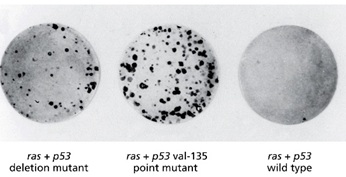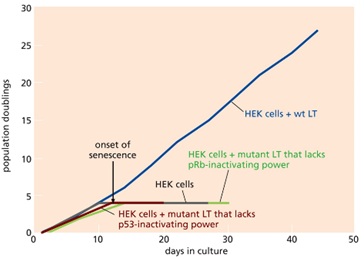Assignment:
There are 20 questions in this problem set. Questions are from lectures 5-9.Each question is worth 5 points. Answer all questions and any sub-questions included in the question.
Answer all questions in your own words. No copying from online sources, book or class notes.. All answers will be screened by plagiarism detection software. Please note any plagiarism detected will result in automatic 0 on this assignment and a repeat will result in reporting to Departmental Academic Integrity committee and a F in the course. You will not be penalized for grammatical or spelling errors.
It is well known that p53 functions as a tumor suppressor protein and that ~50% of cancers carry p53 mutations.
1. Initial attempts to understand the function of p53 suggested it acts as an oncogene based on the data shown in the image below. Explain how the data presented below (first two plate pics) led to the mistaken finding of oncogenic potential of p53

2. Explain how the result in the third plate picture clarified the function of p53 as a tumor suppressor.
3. What is the biological activity of p53 in normal cells that allows it to act as a tumor suppressor?
4. Majority of mutations associated with p53 in cancers are missense mutations rather than nonsense mutations. Explain why.
5. Knowing that p53 val-135 is a dominant negative allele and that p53 functions as a tetramer, explain why the middle plate picture has more transformative foci.
Cells grown in vitro have a limited ability to replicate even provided with nutrients before they enter senescence.
6. What are the physiological differences between senescent cells and cells in G0 phase of the cell cycle?
7. Why do cells from older donors have less replicative lifespan in vitro than cells isolated from younger donors?
8. How does accumulation of p16 INK4A and p21 Cip1 affect the replicative lifespan of cells invitro?
9. Explain the effect of reduction of O2 in the growing environment on the replicative lifespan of cells in vitro. What is the biological reason for this effect?
10. What conclusions can you draw from the results presented in the graph below?

Cells need a way of counting how many divisions they have undergone to keep track of when they enter into senescence or crisis.
11. What feature of chromosomal DNA acts as a cell doubling clock?
12. Explain the role of hTERT protein and hTR RNA in maintaining long chromosomal ends in embryonic stem (ES) cells.
13. Explain how breakage-fusion-bridge cycles result in large scale karyotypic changes in cells under crisis.
14. Explain the molecular details that allow cancer cells to overcome the effects of crisis to become immortal.
15. What is effect of introducing dominant-negative hTERT protein into cancer cells? Explain how this strategy is likely to be exploited by anti-cancer therapeutics.
16. What is the role of E-cadherin in maintaining normal architecture of epithelial tissues?
17. How do cancer cells trigger loss of E-cadherin function and induce the transcriptional changes associated with EMT?
18. What are some molecular markers associated with the epithelial and mesenchymal state? How are they utilized to follow the process of cancer cell invasion?
19. What is the role for reactive stroma in inducing EMT and promoting invasion of the cells that have achieved this transition?
20. Which cell types secrete Colony Stimulation factor (CSF-1)? How does CSF help invasion and metastasis?